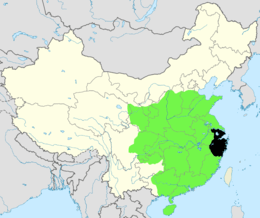Liangzhe Circuit
Liangzhe Circuit (997–1160s) was one of the major circuits during the Song dynasty (960–1279). Its administrative area corresponds roughly to modern Zhejiang, Shanghai, and southern Jiangsu (the portion east of Changzhou, between Lake Tai and the Yangtze). The fertile Yangtze River Delta lay within Liangzhe Circuit, as did Lake Tai. Liangzhe was the wealthiest circuit in Song.
| Liangzhe Circuit | |
|---|---|
| Chinese | 兩浙路 |
| Mandarin | Liǎngzhè Lù |
 Liangzhe Circuit within Song dynasty territory, c. 1100 | |
| Population | |
| • 1102 | ~10 million[1][2] |
| • 1162 | ~11 million[1][2] |
| History | |
| • Preceded by |
|
| • Created | 997 (Song dynasty) |
| • Abolished | 1160s (Song dynasty) |
| • Succeeded by |
|
| • HQ | Hang Prefecture |
The capital of Liangzhe Circuit was Hang Prefecture (renamed Lin'an Prefecture in 1129, when it became the Song capital).
History
Liangzhe Circuit was created in 997, about 19 years after the Wuyue (907–978) king Qian Chu surrendered his kingdom to the Song dynasty. The name Liangzhe (兩浙; "Two Zhe's") had been in use to refer to the two Tang dynasty (618–907) circuits Zhejiang East Circuit and Zhejiang West Circuit, both created in 758 and later controlled by Wuyue. Liangzhe Circuit was not identical to Wuyue territory: it included former Southern Tang prefectures like Chang Prefecture and Run Prefecture, but not Fu Prefecture.
In 1074, Liangzhe Circuit was divided into 2 circuits: Liangzhe East Circuit and Liangzhe West Circuit, but quickly recombined. After another brief split between 1076 and 1077, Liangzhe Circuit was permanently split in two in the 1160s. (In 1127, following the Jingkang incident, Zhao Gou (Emperor Gaozong) reestablished the Song dynasty in Hang Prefecture, which he renamed to Lin'an Prefecture in 1129.)
References
- This estimate is based on the assumptions that 1) household figures are more reliable than population figures from Song dynasty censuses, and 2) an average household had 5 people. For conflicting views on Song dynasty census figures, see Pritchard, Earl H. (1963). "Thoughts on the Historical Development of the Population of China". The Journal of Asian Studies. 23 (1): 3–20. JSTOR 2050630. and Li Baozhu (李宝柱) (1982). "宋代人口统计问题研究" [A Study on the Song Dynasty Census Problem]. Journal of Peking University (Philosophy and Social Sciences) (in Chinese). 19 (4): 67–77.
- Song Shi, ch. 88.
- Shi Weile, ed. (2005). Zhongguo Lishi Diming Da Cidian (中国历史地名大词典) [Large Dictionary of Chinese Historical Place Names] (in Chinese). China Social Sciences Press. pp. 1244, 2203. ISBN 7-5004-4929-1.